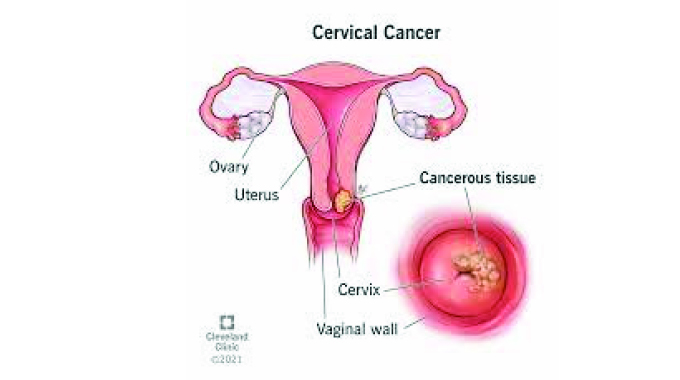Early detection of cervical cancer can save lives

Rumbidzayi Zinyuke, Harare Bureau
CERVICAL cancer remains one of the most dangerous cancers that affect women across the globe.
Worldwide, cervical cancer is the fourth most frequent cancer in women.
About 604 000 new cases were recorded in 2020 while an estimated 342 000 deaths from cervical cancer were reported. Of these deaths, about 90 percent occurred in low and middle-income countries.
In Zimbabwe, cervical cancer is most common among black women.
The country actually has one of the highest burden of cervical cancer in the world.
Statistics from the National Cancer Registry 2018 report, accounted for 39,2 percent of the total number of cancer cases followed by breast cancer (12,5percent) and oesophagus (3,8 percent) among others.
Among non-black Zimbabwean women, cancer of the cervix accounted for 4,9 percent of all cancer cases reported in the period after breast cancer, lung cancer, melanoma skin cancer, corpus uteri and colon cancer.
What is worrying is that cervical cancer was the leading cause of death among all cancer deaths reported in the country in 2018.
“A total of 2 743 cancer deaths comprising 1 248 (45,5 percent) males and 1 495 (54,5 percent) females were recorded in Harare, Chitungwiza and Bulawayo in 2018. The leading causes of the deaths were cervical cancer (13 percent), prostate (10 percent), breast (7 percent), oesophagus (7 percent), liver (7 percent), non-Hodgkin lymphoma (6 percent), stomach (5 percent), lung (5 percent), and colo-rectal (4 percent). The other cancers constituted 36 percent of the recorded deaths,” the National Cancer Registry noted.

National Cancer Registry
What could be contributing to the high mortality among cervical cancer patients is the delayed detection of cases.
Out of the 3 535 cases with a known stage of disease at diagnosis, 2 813 (about 80 percent) were in stage 3 and 4.
A cancer?stage describes the extent to which the cancer has spread in the body from where it first formed.
When cervical cancer is detected in stage 3, it means it has spread to the lower third of the vulva and the pelvic wall. Sometimes it would have already caused kidney problems and affected the lymph nodes.
Stage 4 means the cancer has spread beyond the pelvis to the lining of the bladder, the rectum or has spread to other parts of the body. This stage is also called metastatic cancer, which happens when cancer cells spread through the lymphatic system or blood to form tumours in other parts of the body.
If the majority of women diagnosed with cervical cancer are already at this stage, it then makes sense why they account for the most deaths from any other form of cancer.
January is Cervical Cancer Awareness Month; hence it becomes more important to educate people on the importance of getting screened for cervical cancer (or any other form of cancer for that matter) regularly.
This type of cancer is preventable and can be treated if detected early.
Most cervical cancer can be traced to the Human Papillomavirus (HPV), which is mainly transmitted through sexual contact. This means most people are infected with HPV shortly after the onset of sexual activity. However, more than 90 percent of them clear the infection eventually.

Human Papilloma Virus (HPV) vaccine
Once cancer cells have developed in the cervix, it can be cured if diagnosed at an early stage and treatment is offered promptly.
Experts say it can take between 15 to 20 years for cervical cancer to develop in women with normal immune systems. However, for those with weakened immune systems, such as those with untreated HIV infection, it can take only five to 10 years.
The most cost-effective way to prevent cancer, particularly for low income countries such as Zimbabwe is vaccination against HPV as well as screening and treatment of pre-cancer abrasions.
Although many countries in the sub Saharan Africa region have limited access to preventative measures such as HPV vaccination and cervical cancer is still being identified at a later stage, progress is being made.
In Zimbabwe, Government rolled out an HPV vaccination exercise targeting girls between the ages of nine and 14 years in 2018.
The inoculations were done mostly in schools and in health institutions so as to ensure that all girls could be reached.
This programme, is expected to reduce the incidence of cervical cancer among the girls as they grow up and become sexually active.
Besides vaccination, screening is also one of the most important tool in fighting cervical cancer.
Most women tend to dread visiting a health facility for screening and they only do so once they realise there could be something wrong within their bodies. By this time, it may already be too late.
The goal for screening for cervical cancer is to find pre-cancerous cell changes early when treatment can be offered to prevent cancer from developing.
The main ways to screen for cervical cancer include the HPV test to check for infection that can cause cervical cancer, a pap smear (cervical cytology) where cervical cells can be checked for changes caused by HPV that may turn into cervical cancer if left untreated. A pap smear can also sometimes detect conditions that are not cancer.
Zimbabwe has also made strides in ensuring that many women, particularly those in marginalised communities can access screening services through the Visual Inspection with Acetic Acid and Camera (VIAC) services offered at various health centres.
VIAC involves examining the opening of the womb, or the cervix, for changes that may lead to cancer. If these changes are detected early, the cells can be eliminated before they become cancerous.
Screening is usually recommended from the age of 25 in the general population of women, with regular screening every three years while women living with HIV also need to be screened more frequently.
Screening must however be linked with treatment and management for those with positive screening tests.
Symptoms of early-stage cervical cancer may include irregular blood spotting or light bleeding between periods in women of reproductive age, postmenopausal spotting or bleeding, bleeding after sexual intercourse, and increased vaginal discharge which can sometimes produce a foul smell.
As cervical cancer advances, more severe symptoms may appear including persistent back, leg or pelvic pain, weight loss, fatigue, loss of appetite, foul-smell discharge and vaginal discomfort as well as swelling of the legs.
Other severe symptoms may arise at advanced stages depending on which organs the cancer has spread to.
The World Health Assembly adopted the global strategy to accelerate the elimination of cervical cancer as a public health problem.
Countries are expected to reach the threshold of less than four cases of cervical cancer per 100 000 women per year for them to be classified in the elimination of cancer stage.
The World Health Organisation has set up the 90-70-90 targets to be reached by 2030 and to be maintained.
This means that 90 percent of girls should be fully vaccinated with HPV vaccine by age 15, while 70 percent of women are screened with a high-performance test by age 35, and again by 45 years of age and 90 percent of women identified with cervical disease should receive treatment (90 percent of women with pre-cancer treated; 90 percent of women with invasive cancer managed).
Zimbabwe and indeed many other countries in the region will need to put extra effort towards the attainment of these goals. This will need more investment towards screening, vaccination and treatment.
However, more energy should also be directed towards raising awareness among women of this disease and how it can affect them if left untreated.
A population that is aware of the dangers of cervical cancer can indeed manage to reduce incidence and eventually eliminate the disease.
Screening can save lives!
Feedback: [email protected]












Comments